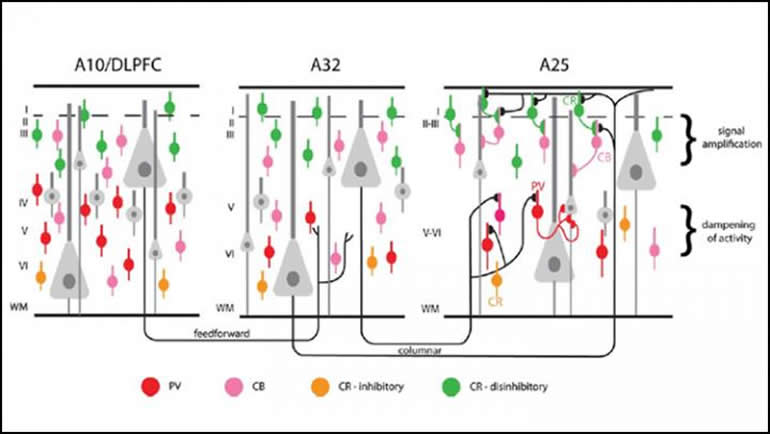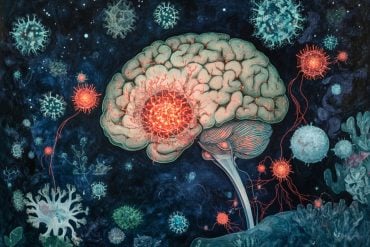Summary: Area 32, a region of the anterior cingulate, balances activity from cognitive and emotional areas of the primate brain.
Source: SfN
Navigating through life requires balancing emotion and reason, a feat accomplished by the brain region “area 32” of the anterior cingulate cortex. The area maintains emotional equilibrium by relaying information between cognitive and emotional brain regions, according to new research in monkeys published in Journal of Neuroscience.
Emotional balance goes haywire in mood disorders like depression, leading to unchecked negative emotions and an inability to break out of rumination. In fact, people with depression often have an overactive area 25, a region involved in emotional expression.
Healthy emotional regulation requires communication between cognitive regions, like the dorsolateral prefrontal cortex (DLPFC), and emotion regions, like area 25, also known as the subgenual cortex. But because these two areas are weakly connected, there must be a middleman involved.
Joyce et al. used bidirectional neuron tracers to visualize the connections between the DLPFC, area 25, and area 32, a potential middleman, in rhesus monkeys. The DLPFC connects to the deepest layers of area 32, where the strongest inhibitory neurons reside. Area 32 connects to every layer of area 25, positioning it as a powerful regulator of area 25 activity.

In healthy brains, the DLPFC signals to area 32 to balance area 25 activity, allowing emotional equilibrium. But in depression, silence from the DLPFC results in too much area 25 activity and out-of-control emotional processing.
About this neuroscience research article
Source:
Garvan Institute of Medical Research
Contacts:
Calli McMurray – SfN
Image Source:
The image is credited to Joyce et al., JNeurosci 2020.
Original Research: Closed access
“Serial Prefrontal Pathways Are Positioned To Balance Cognition and Emotion in Primates” by Mary Kate P. Joyce, Miguel Ángel García-Cabezas, Yohan J. John and Helen Barbas. Journal of Neuroscience.
Abstract
Serial Prefrontal Pathways Are Positioned To Balance Cognition and Emotion in Primates
The delicate balance among primate prefrontal networks is necessary for homeostasis and behavioral flexibility. Dorsolateral prefrontal cortex (DLPFC) is associated with cognition, while the most ventromedial subgenual cingulate area 25 (A25), is associated with emotion and emotional expression. Yet A25 is weakly connected with DLPFC and it is unknown how the two regions communicate. In rhesus monkeys of both sexes, we investigated how these functionally distinct areas may interact through pregenual anterior cingulate area 32 (A32), which is strongly connected with both. We found that DLPFC innervated the deep layers of A32, while A32 innervated all layers of A25, mostly targeting spines of excitatory neurons. About 20% of A32 terminations formed synapses on inhibitory neurons in A25, notably the powerful parvalbumin inhibitory neurons in the deep layers, and the disinhibitory calretinin neurons in the superficial layers. By innervating distinct inhibitory microenvironments in laminar compartments, A32 is positioned to tune activity in columns of A25. The circuitry of the sequential pathway indicates that when DLPFC is engaged, A32 can dampen A25 output through the parvalbumin inhibitory microsystem in the deep layers of A25. A32 thus may flexibly recruit or reduce activity in A25 to maintain emotional equilibrium, a process that is disrupted in depression. Moreover, pyramidal neurons in A25 had a heightened density of NMDA receptors, which are the targets of novel rapid-acting antidepressants. Pharmacologic antagonism of NMDA receptors in patients with depression may reduce excitability in A25, mimicking the effects of the neurotypical serial pathway identified here.
SIGNIFICANCE STATEMENT:
The anterior cingulate is a critical hub in prefrontal networks through connections with functionally distinct areas. Dorsolateral and polar prefrontal areas that are associated with complex cognition are connected with the anterior cingulate in a pattern that allows them to indirectly control downstream activity from the anterior cingulate to the subgenual cingulate, which is associated with heightened activity and negative affect in depression. This set of pathways provides a circuit mechanism for emotional regulation, with the anterior cingulate playing a balancing role for integration of cognitive and emotional processes. Disruption of these pathways may perturb network function and the ability to regulate cognitive and affective processes based on context.







